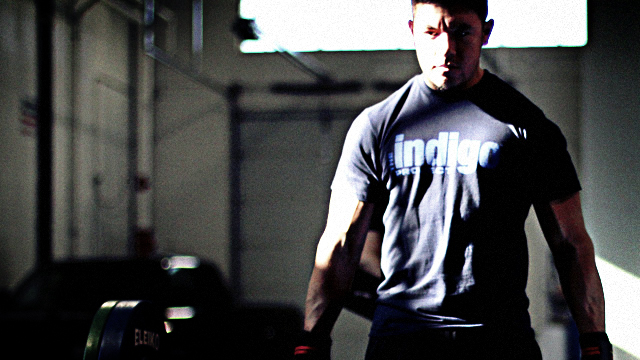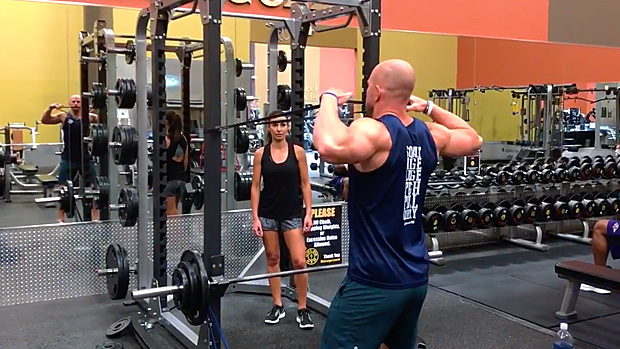"What else can I do?"
This was my attitude as a green college freshman at a small, highly academic school. Our chess team was renowned, but the baseball team? Not so much.
I retain a mental snapshot of one day in the varsity weight room. It was empty and I was dripping sweat onto a pair of 65-pound dumbbells, my back foot resting on a red bench. As I sat them down to recollect my balance during a set of Bulgarian split squats, my strength coach came over and sat at the bench press next to me.
"Why are you always the last one here? Everyone else finished 10 minutes ago."
I was deflated by the question, mostly because I was in the middle of a set of 12 per leg Bulgarian split squats. I was gassed and about to eclipse the 70-minute mark for my workout.
"I don't know, Coach. I'm not cheating, that's for sure."
He told me to move more quickly and that my workout was done for the day. I was happy to be on my way to the dining hall, but dissatisfied that I hadn't finished.
I look back and am proud that I was that guy, the last one to leave. Thing was, though, I stopped being that guy as soon as I left college. It wasn't that I lost my work ethic; rather, I came to the epiphany that I couldn't continue to kill myself daily in the gym and expect to live through it – it wouldn't work in the long run.
In this article I'm going to share some of my methods for making long-term progress while maintaining long-term sanity. I'm by no means Dave Tate, but I'm approaching the 10-year mark on my affair with training and am tired of going to bed angry.
1 – More Days, Shorter Workouts
Then – 3-4 Days per week, 6-8 exercises per day.
In college I built myself on a diet of 6-8 exercise workouts. This would typically turn me in at 18-25 sets per session. This was the reason I could barely finish workouts, and why I needed to look introspectively for the answer: I worked too hard to handle that kind of volume. Grunting out every single set for 25 sets is exhausting.
The average college athlete, who works at an average intensity, finds this volume to be about right – he needs the extra sets because he's not pushing himself to the limit. That's okay – we just need to know which version we are. If you work hard, you'll be fine with fewer sets. If you work at a moderate intensity, throw a few more exercises on that day's whiteboard.

Now – 5-6 days per week, 3-5 exercises per day.
I can't perform a 60-minute high-intensity workout anymore, especially because I often train without a partner (more on that later). With the demands of running a business, fitting in my pitching and arm care, and maintaining a personal life (sort of), I just don't have the mental energy. But, I like to lift heavy things.
I write workouts that I can do in 40 minutes and I plan to train 5 or 6 days per week. Some weeks I get in 6 workouts, others just 5. Either way, I feel refreshed when 1:30 PM rolls around because I only have to make it to 2:10 and I'm free to get back to pecking away at my to-do list. I work hard for a short amount of time; get in and get out.
What To Do – Break it up.
If you're currently on a 3 or 4-day split, I suggest the following:
- Audit your program (Dan John just wrote a very cool article on this) and get the breakdown of what you're doing.
- Take the total volume and chop it up into 6 chunks. These are now your workouts.
- Plan to get 5 workouts done per week. Feel accomplished if you get all 6.
2 – Program In "Pansy Time"
Then – No wasted time. No water. No air. Only iron.
I used to feel like I had to get started right when I walked in the door and finish at the 60-minute mark. I had to keep moving from one exercise to the next with no breaks.
I don't like working under such deadlines. It makes me feel stressed and rushed, which lessens the enjoyment I get out of training.
Now – 20 minutes of pansy time.
"Pansy time" is the collection of little moments when I'm dragging my feet or just feel like I need an extra minute before my next set.
I try to lift every day at 1:30PM. Nine days out of 10, I end up starting at 1:40. I design workouts to be 40 minutes or less. Nine days out of 10, they take me 50.
So I account for this and block off 1:30-2:30 as my lifting window. I know that I'm not going to actually train that whole time, but I budget it out anyway. It gives me peace of mind knowing this because I'm not expecting myself to be done until 2:30; I can thus screw around for an extra few minutes and still not encroach on the rest of my daily tasks.
What To Do – Be more of a pansy.
Just relax a bit during your workouts. Kill it during your set, but if you need a few extra seconds or a little more water, take it. Share a brief story with your training partner. Send that 30-second email if your mind is fixated on it. Leave the session feeling better, because you got to enjoy it a bit more.
3 – Get a Training Partner
Then – Lifting was mandatory. We had to be there, like it or not.
It was great being forced to do things you knew you wanted to do anyway. It surrounded you with others in the same struggle, all trying to get better. I really, really took this atmosphere for granted.

Now – No solo lifting.
Bret Contreras wrote recently about how important training partners can be. I suck when training alone. I didn't realize I sucked so hard at it until about 5 years ago when I was first thrust into the adult world. It's not that easy to work yourself to death when no one is watching – just ask those prison inmates on the side of the highway. They wouldn't be nearly as good at picking up trash if not for the armed guards.
What To Do – Find a partner or partners.
I have two training partners right now, mostly because all three of us have different schedules. I tell them that I'd be working out alone if not for them, so any day they can meet me is a blessing. I push them and they push me. Doesn't need much more explanation than that.
4 – Interact With Said Partners
Then – I'm breathing too hard to talk.
In college I wasn't Dan. Rather, I was "that guy who was always covered in sweat." I had lots of fellow athletes next to me in the weight room. Did I talk to them? Learn their story? No. I stared straight at the iron and passed them by. What an idiot I was. I got great results, but missed a lot of opportunities to interact. The gym is not the place to meet girls or get wrapped up in conversation. It is, however, a great place to say hello, put a name to a face, and develop some camaraderie.
Now – I'm breathing hard, But I can listen.
I train with two guys both two decades older than I. I soak up their wisdom, and they enjoy living vicariously through my bachelorhood. That said, some days I like to take an extra two minutes between sets and let them finish a story. I don't want to let valuable life-lessons pass me by because I must squat right now. I enjoy my workouts much more when I allow myself to have a laugh and share a quick story between sets. We all immediately zip back to work after our training session, so if we don't speak during, we don't speak at all.
What To Do – Blab on, but find a balance.
Make a contract with your partners if necessary. If your training partner likes to talk more than you, create an "I'm going to cut you off, but it doesn't mean I don't love you" pact. I've learned to do this. If it's time to squat, I squat. He can finish the thought when my set is over. When it's his turn to squat, I shut up. There's no point training with a friend if you can't enjoy the interaction that drives the friendship.
5 – Trust In Accumulation
Then – I must get stronger now.
I simply ran out of gas beating myself to death in 75-minute workouts 4 days a week with interval sprint work in between. Add that to a 100 games of summer baseball in 110 days and it's no wonder why I absolutely hated training for a few years. I forced myself to do it, but knew I couldn't keep it up for the rest of my life. I had a poor balance and was draining myself, mentally and physically.
Now – I am a sea sponge, slowly filtering spores of strong.
I've read a huge amount of powerlifting literature in the past year. It stunned me that they all kept saying the same thing – increase GPP, don't miss reps, live to fight another day, and look to slow but consistent gains; exactly the opposite of what I was expecting. If super-strong dudes say that, I'd be an idiot to not listen. It took a while to sink in, but I'm a believer.
This is the reason I don't fret about sharing an extra story during a workout. It's not an excuse to be lazy, it's a reason to relax and trust that over a lifetime of training, small doses add up to large gains. Live life a little more and enjoy the little things because a trickle of quality training, day in and day out, will keep paying dividends decades from now.
6 – Meditate: Train Your Mind
Then – My brain won't turn off.
Over a year ago I came to realize that I needed mental training to increase my baseball prowess. I wouldn't reach my goals without the increased edge it would give me. I turned to meditation on the recommendation of my now good friend and mentor, Alan Jaeger.
I've got a B.A. in Philosophy and Psychology. My brain is a busy, busy thing. It never shuts off and used to prevent me from truly relaxing.

Now – My brain doesn't care.
Fourteen months of consistent meditation later and I get no physical reaction from stress. I just take a belly breath and I'm calm (believe me, I've been tested in the last year). I no longer worry and I rarely get rattled. I'm always relaxed and trust that there's a solution to every problem. It didn't used to be this way, and I could talk for hours about how much my life has improved as a result of taking 20 minutes per day to lie flat on my back and meditate.
What To Do:
Pencil 20 minutes for yourself after your workout. If you train at a commercial gym, sneak to an unused yoga room or simply wait until you get home. All you have to do is find a quiet space, sit in a comfy chair cross-legged, or lie flat on your back. Breathe from your belly and allow yourself to float away, getting lost in the quiet.
You can count your breaths to help clear your mind or just let it wander. Meditation is simple, highly customizable, and absolutely incredible for mental recovery after a tough workout. You might be antsy at first so give it a week and remind yourself that sitting still is a skill that needs practice like everything else.
Retrieve Your Sanity and Keep On
Long-term adherence is what we're ultimately after, and we need to continually assess our methods to ensure we're on the right track. You don't want the next fad diet, workout program, or sense of style. Parachute pants always looked ridiculous. Put those Levi's back on, employ a few of the above methods and keep inching forward.





